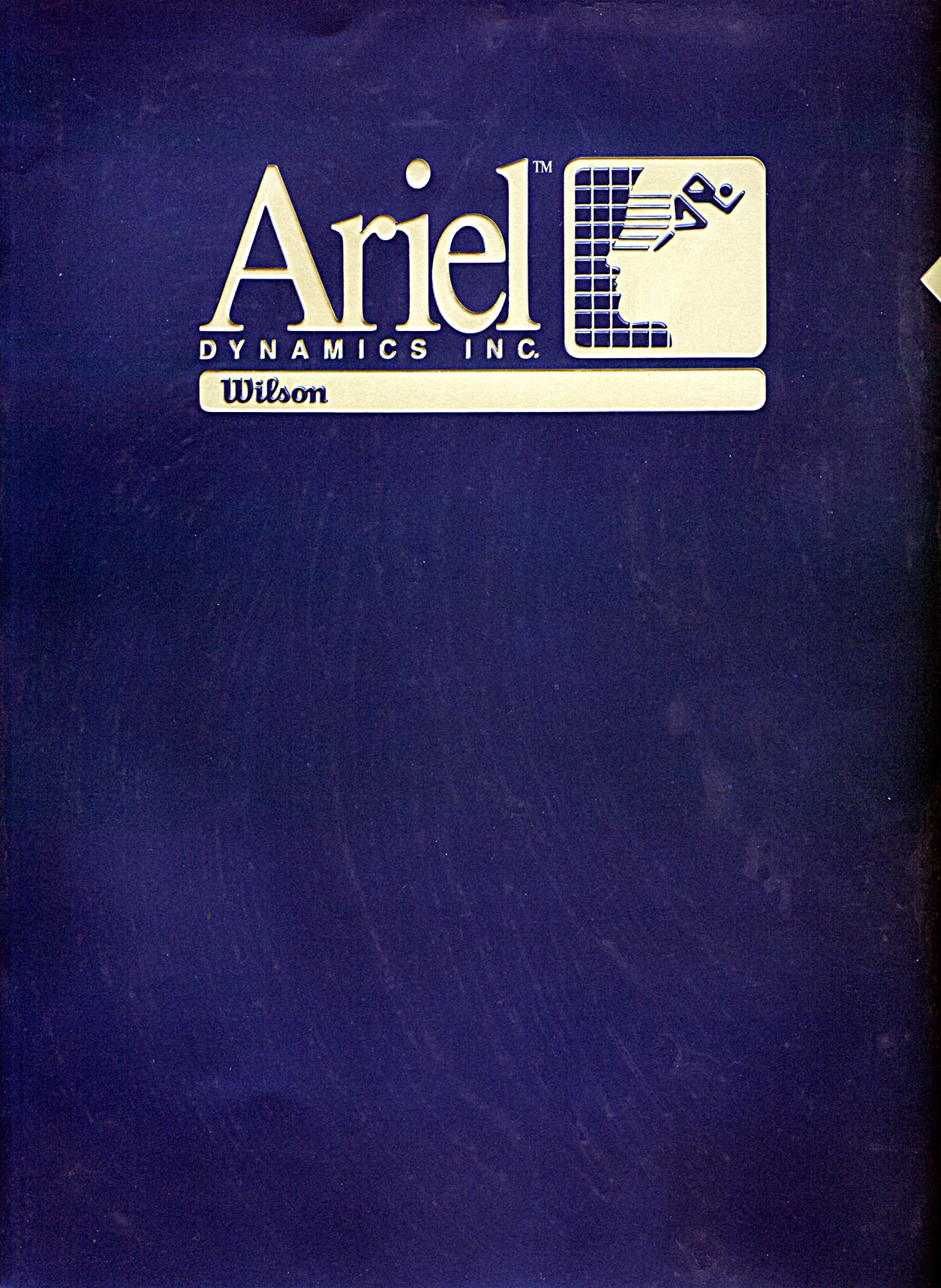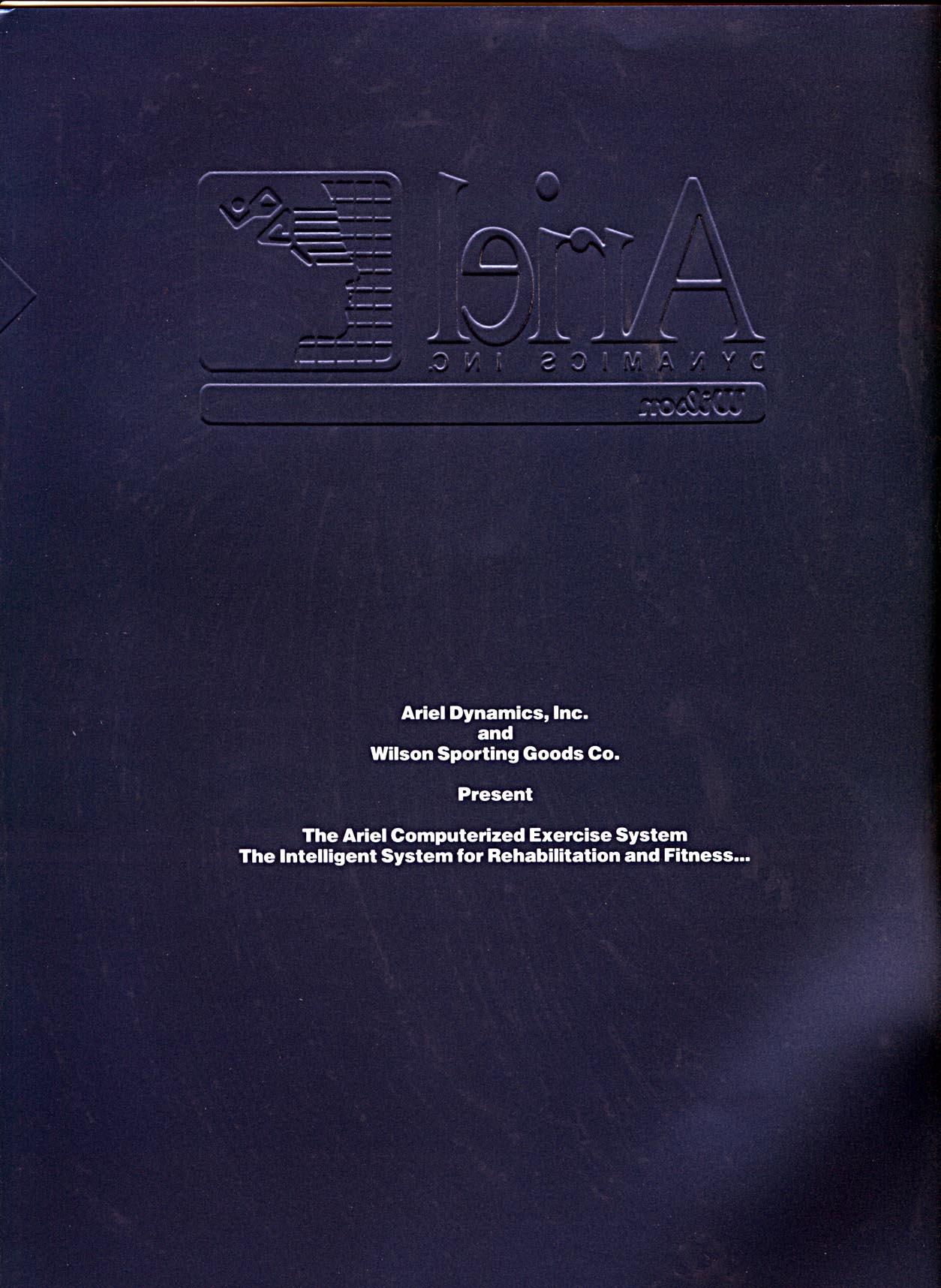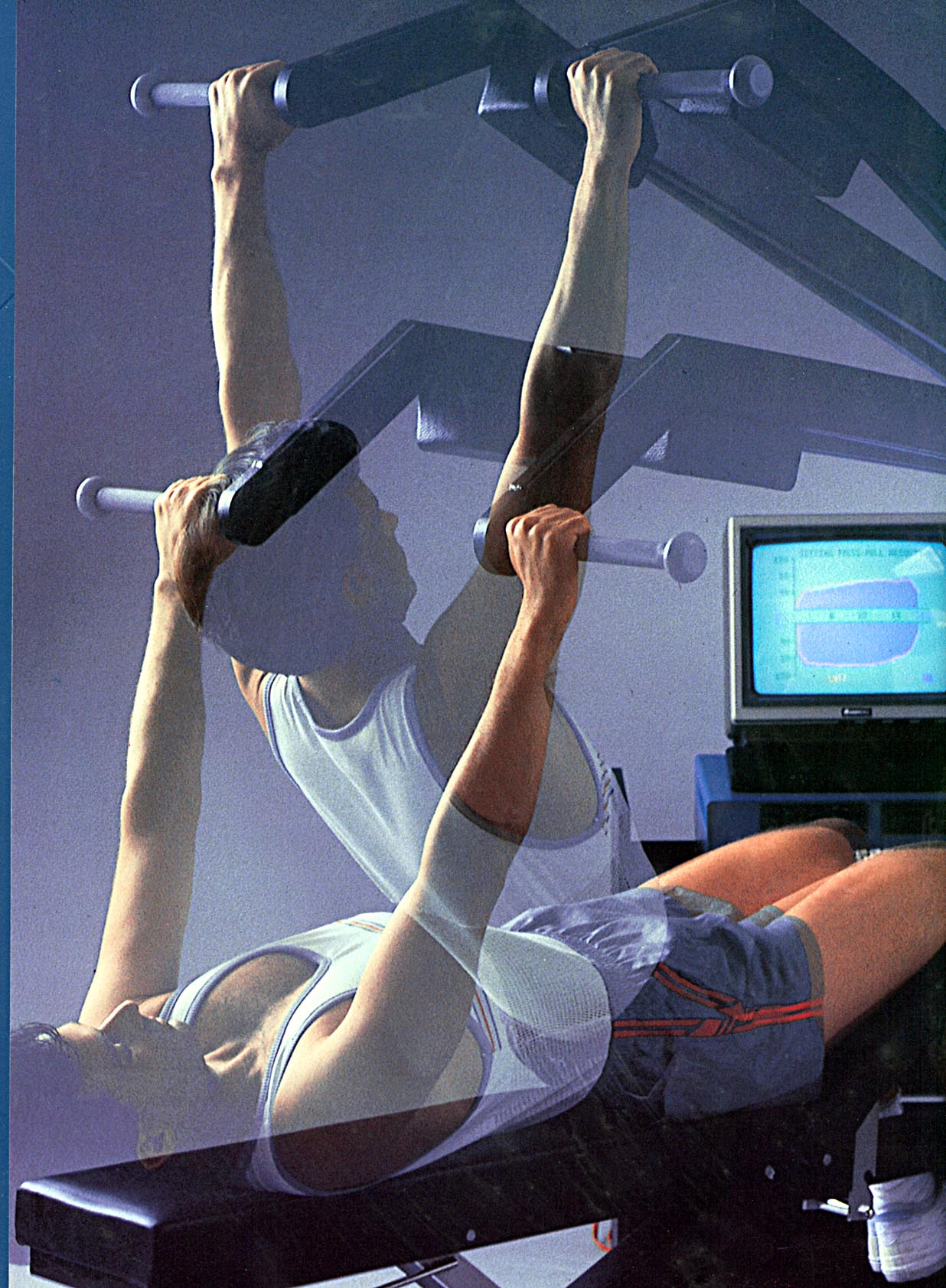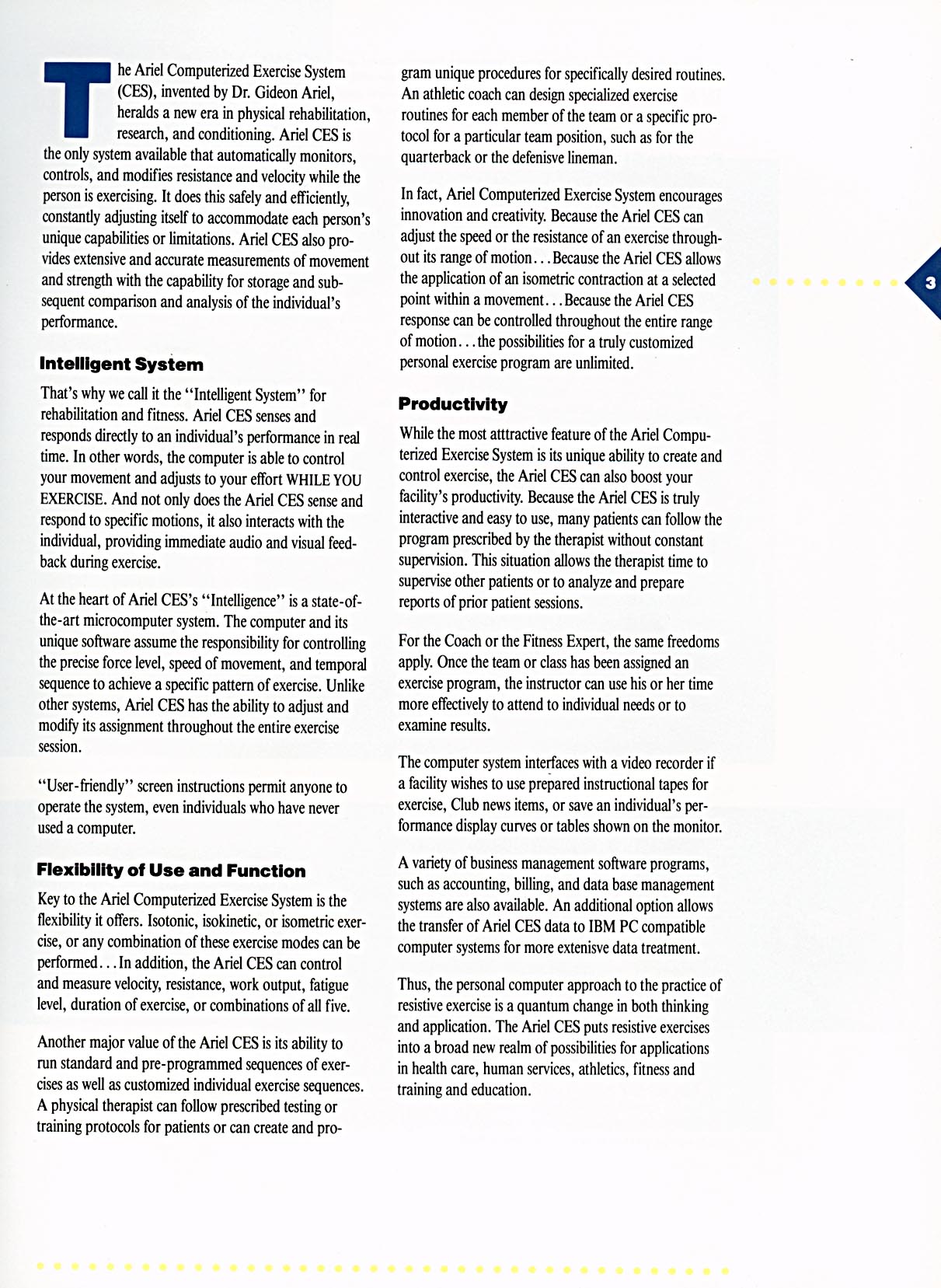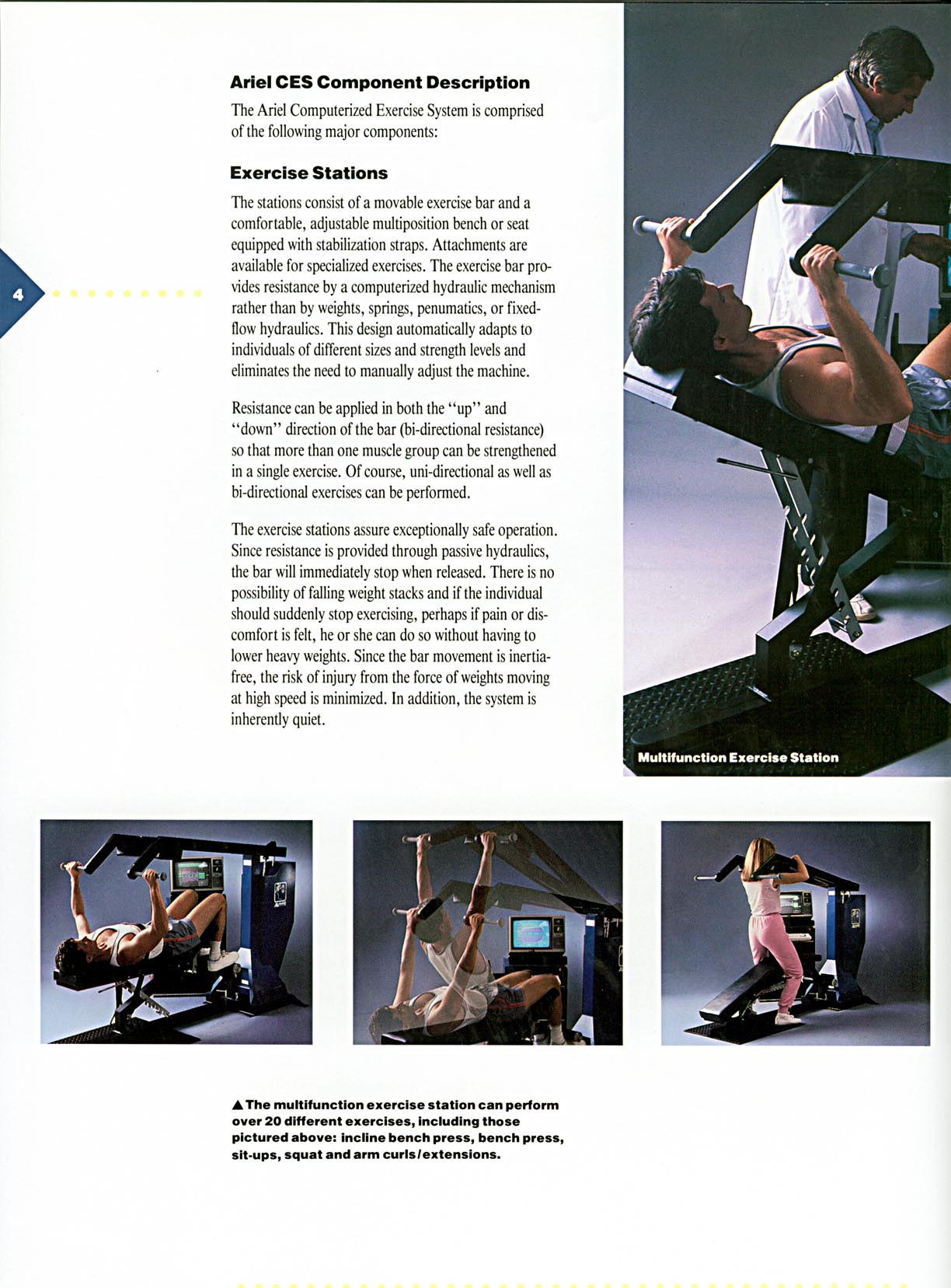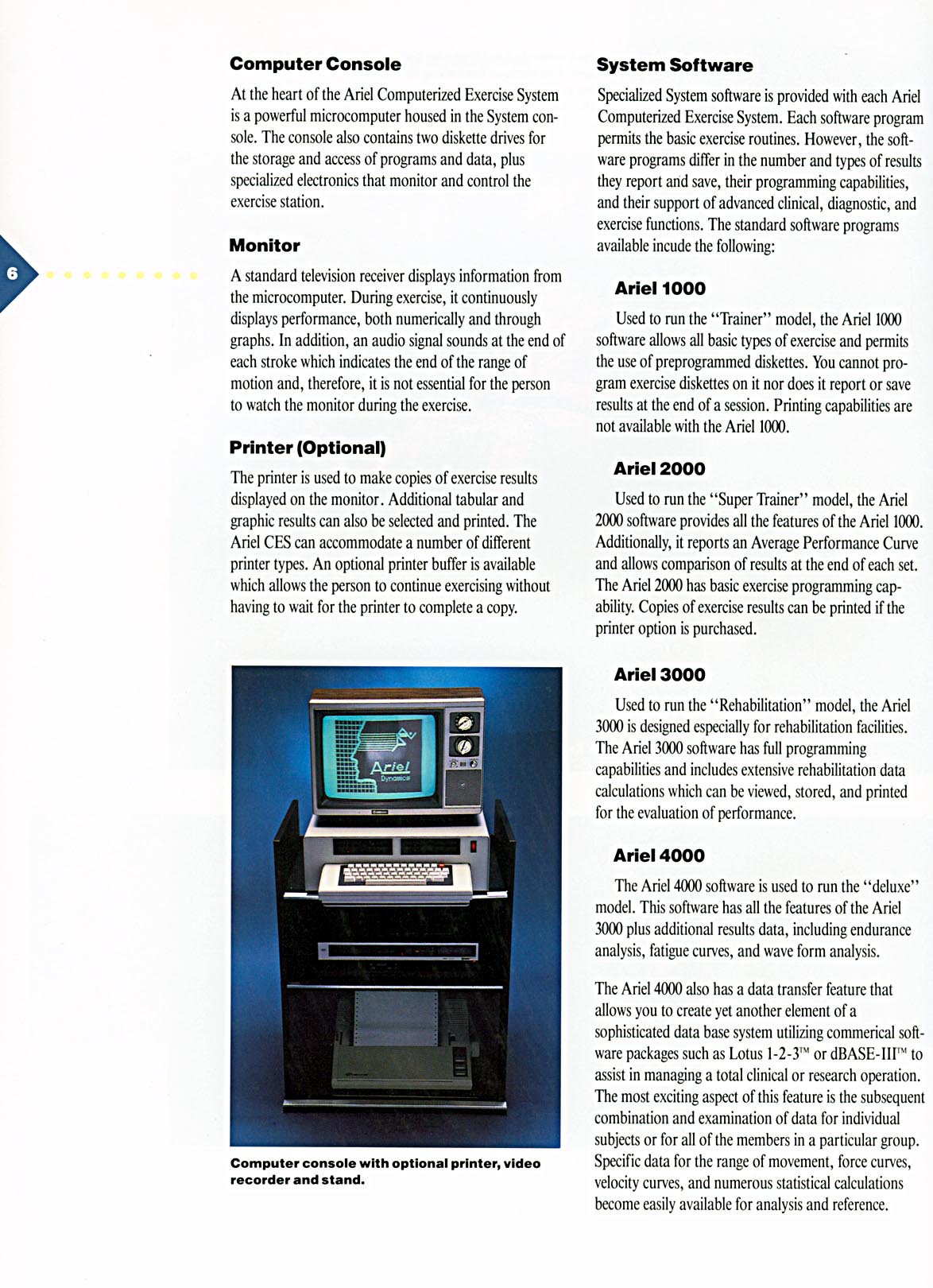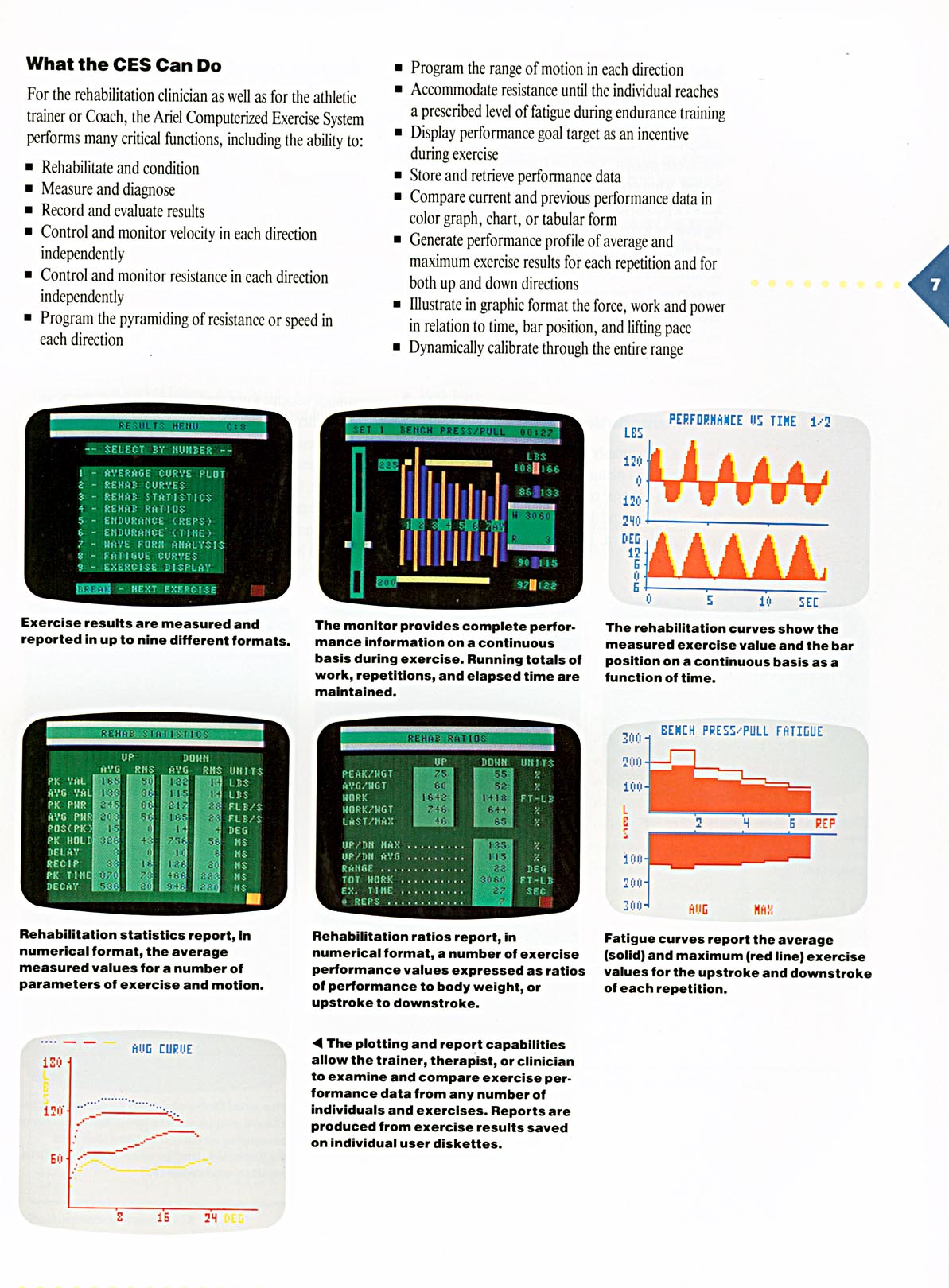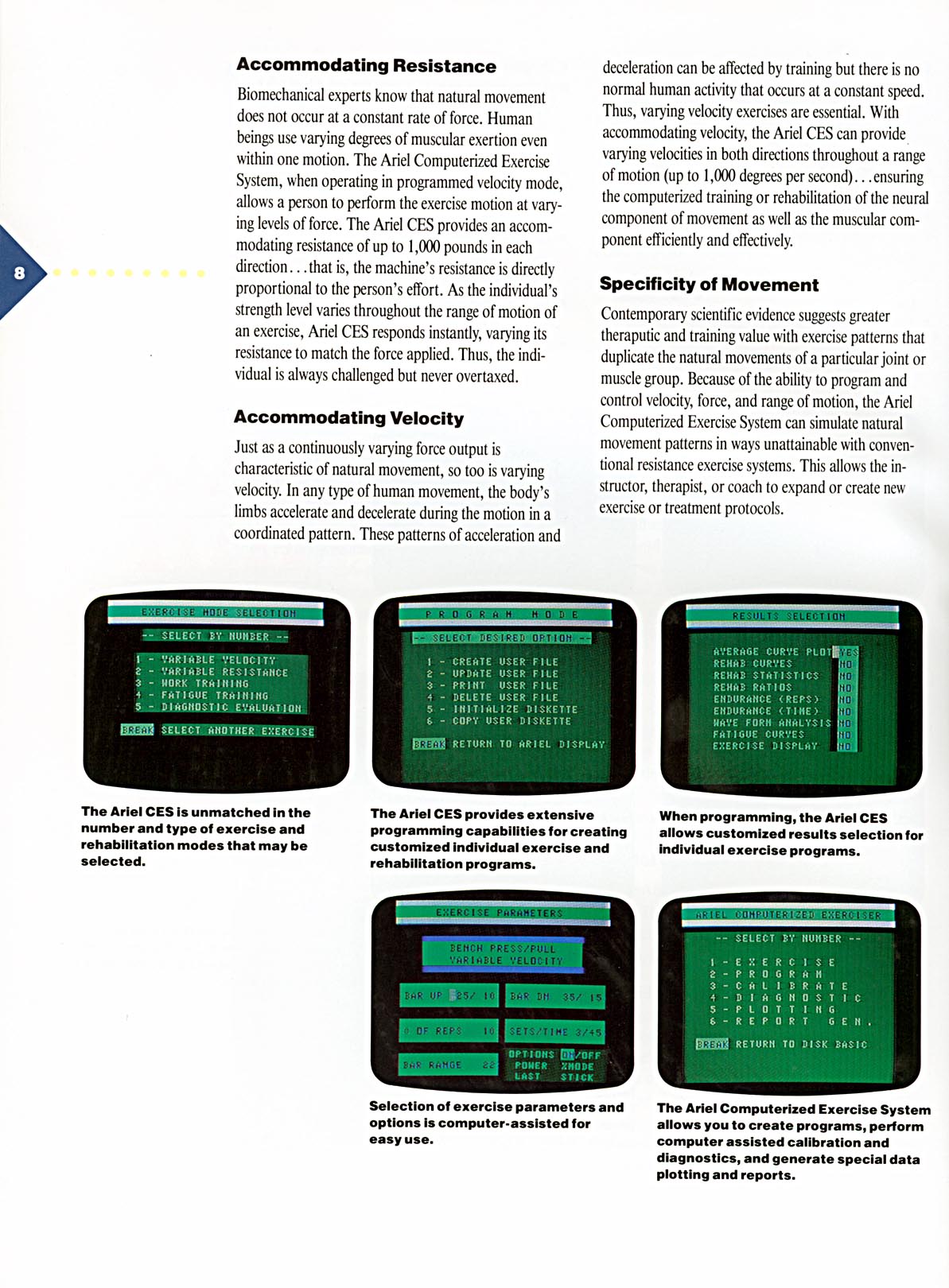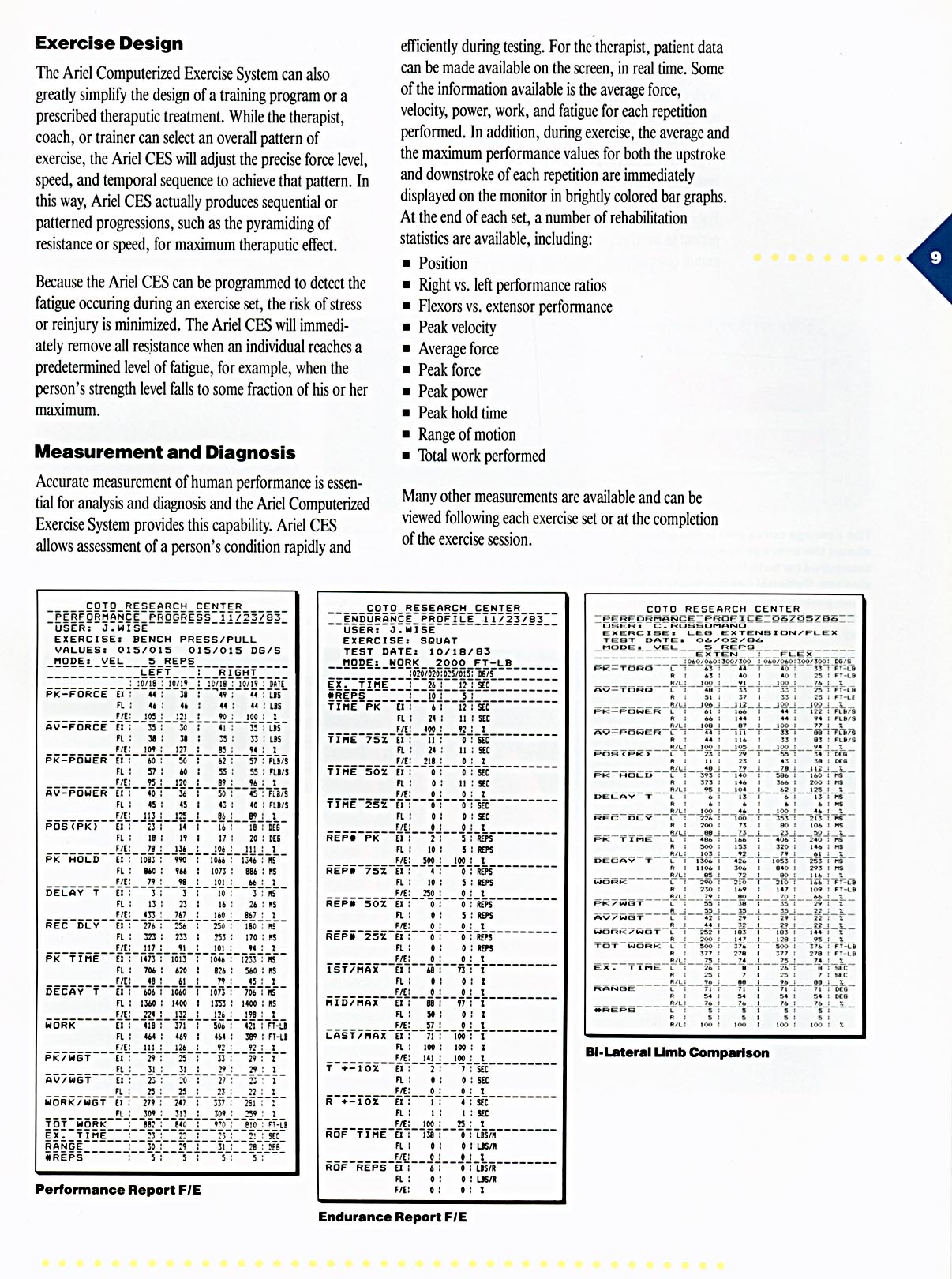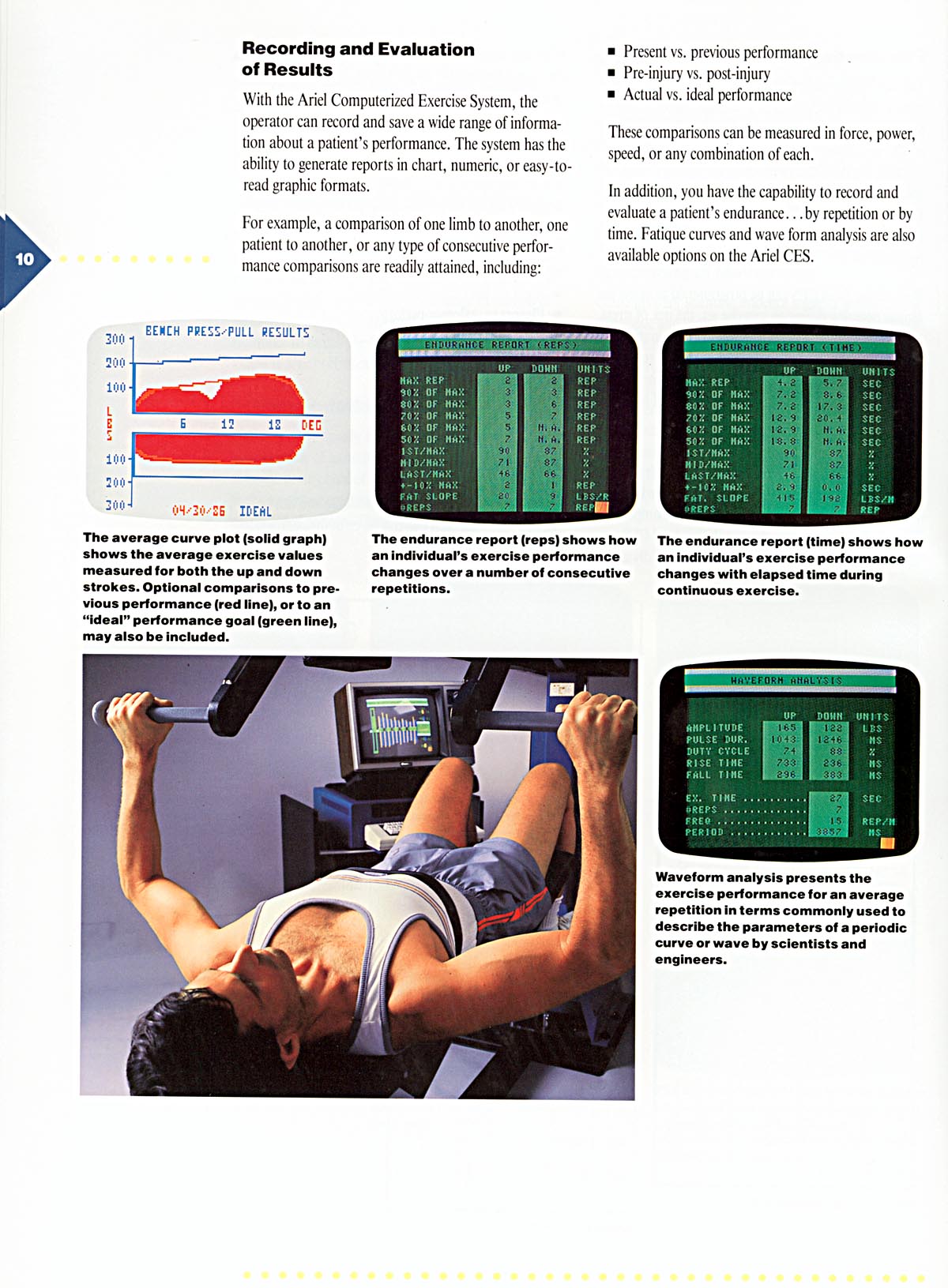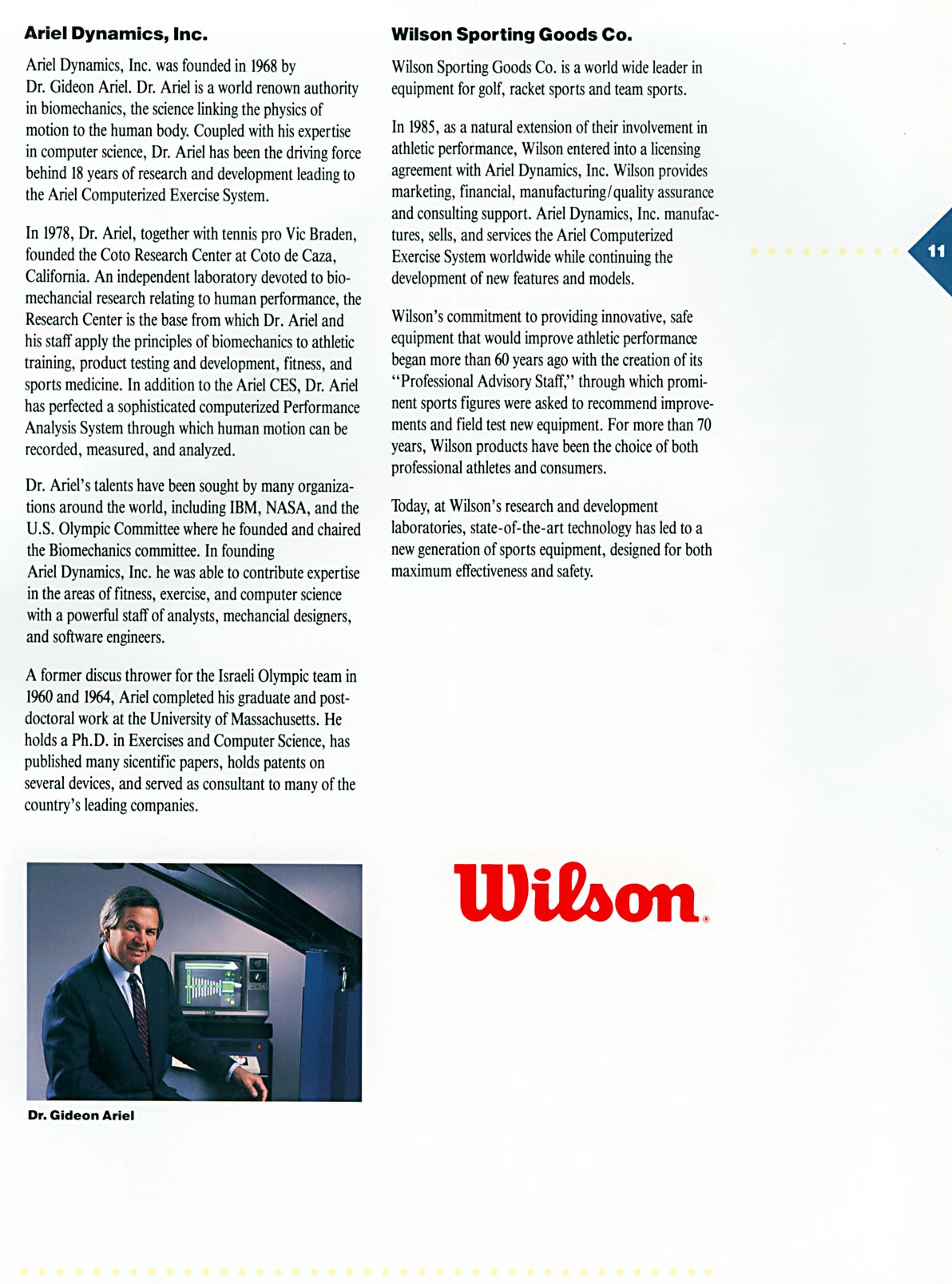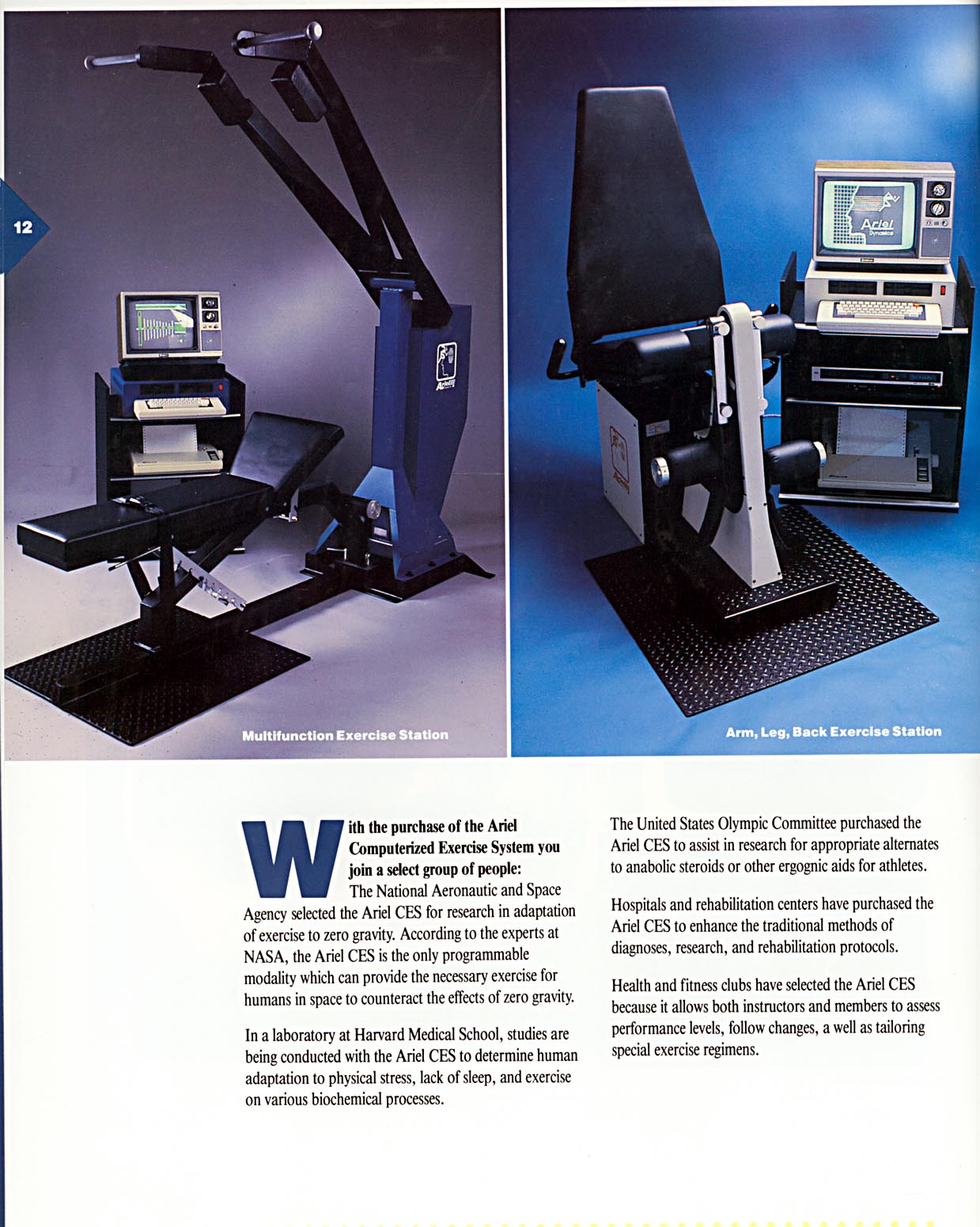Wilson-Ariel Products
Brochure from 1986
By Gideon Ariel in Wilson-Ariel Brochure on Wednesday, January 1, 1986
The Ariel Computerized Exercise System (CES) is a revolutionary tool in the fields of rehabilitation and fitness. Developed by Ariel Dynamics, Inc. and Wilson Sporting Goods Co., the system uses a state-of-the-art microcomputer to monitor, control, and modify resistance and velocity during exercise. The system is designed to accommodate each individual's unique capabilities or limitations, providing accurate measurements of movement and strength. The Ariel CES also offers extensive programming capabilities, allowing therapists and trainers to design customized exercise routines. The system is user-friendly and can boost productivity in a facility, as it allows patients to follow prescribed programs without constant supervision. The Ariel CES is comprised of exercise stations, a computer console, a monitor, and optional printer. The system software includes four different programs, each offering different features and capabilities. The Ariel CES is a significant advancement in the practice of resistive exercise, offering a broad range of possibilities for applications in health care, athletics, fitness, training, and education.
Ariel Dynamics: Revolutionizing Fitness and Exercise with Technology
This article discusses the significant contributions of Ariel Dynamics, Inc., a company founded by Dr. Gideon Ariel, a former Israeli Olympic discus thrower and a Ph.D. holder in Exercises and Computer Science. Ariel Dynamics specializes in the integration of fitness, exercise, and computer science, offering innovative solutions in these fields with a team of expert analysts, mechanical designers, and software engineers.
The company's flagship product, the Ariel Computerized Exercise System (CES), has been recognized and utilized by prestigious organizations worldwide, including NASA, the U.S. Olympic Committee, and various hospitals and fitness clubs. The Ariel CES is a programmable modality that provides necessary exercise to counteract the effects of zero gravity, making it an essential tool for NASA's research in space. It is also used in studies at Harvard Medical School to understand human adaptation to physical stress and lack of sleep.
In 1985, Ariel Dynamics entered into a licensing agreement with Wilson Sporting Goods Co., a global leader in sports equipment. This partnership has allowed Ariel Dynamics to manufacture, sell, and service the Ariel CES worldwide while continuing to develop new features and models. Wilson provides marketing, financial, manufacturing/quality assurance, and consulting support to Ariel Dynamics.
The article concludes by highlighting the innovative and safe sports equipment developed by Wilson's research and development laboratories, which have been the choice of professional athletes and consumers for over 70 years.
Tip: use the left and right arrow keys
Ariel Dynamics, Inc.andWilson Sporting Goods Co.
Present
The Ariel Computerized Exercise SystemThe Intelligent System for Rehabilitation and Fitness...
The skilled hand...the trained eye...traditionally these have been the most valuable tools for experts in the fields of rehabilitation and fitness. However, even these tools cannot help the therapist or trainer evaluate the exact amount of resistance or velocity needed to strengthen or rehabilitate an injury. Although these professionals have the benefit of many years of experience, objective measurements and comparisons with previous performance have often been unavailable.
Over the years, many machines have been developed to provide general exercise and strength training. More recently, equipment that measures and records precise levels of muscular strength and range of movement has become available. But there has been no machine that could intelligently simulate, respond to, and analyze human movement ... until now.
The Ariel Computerized Exercise System (CES), invented by Dr. Gideon Ariel, heralds a new era in physical rehabilitation, research, and conditioning. Ariel CES is the only system available that automatically monitors, controls, and modifies resistance and velocity while the person is exercising. It does this safely and efficiently, constantly adjusting itself to accommodate each person's unique capabilities or limitations. Ariel CES also provides extensive and accurate measurements of movement and strength with the capability for storage and subsequent comparison and analysis of the individual's performance.
Intelligent System
That's why we call it the "Intelligent System" for rehabilitation and fitness. Ariel CES senses and responds directly to an individual's performance in real time. In other words, the computer is able to control your movement and adjusts to your effort WHILE YOU EXERCISE. And not only does the Ariel CES sense and respond to specific motions, it also interacts with the individual, providing immediate audio and visual feedback during exercise.
At the heart of Adel CES's "Intelligence" is a state-ofthe-art microcomputer system. The computer and its unique software assume the responsibility for controlling the precise force level, speed of movement, and temporal sequence to achieve a specific pattern of exercise. Unlike other systems, Ariel CES has the ability to adjust and modify its assignment throughout the entire exercise session.
"User-friendly" screen instructions permit anyone to operate the system, even individuals who have never used a computer.
Flexibility of Use and Function
Key to the Ariel Computerized Exercise System is the flexibility it offers. Isotonic, isokinetic, or isometric exercise, or any combination of these exercise modes can be performed... In addition, the Ariel CES can control and measure velocity, resistance, work output, fatigue level, duration of exercise, or combinations of all five.
Another major value of the Ariel CES is its ability to run standard and pre-programmed sequences of exercises as well as customized individual exercise sequences. A physical therapist can follow prescribed testing or training protocols for patients or can create and program unique procedures for specifically desired routines. An athletic coach can design specialized exercise routines for each member of the team or a specific protocol for a particular team position, such as for the quarterback or the defenisve lineman.
In fact, Adel Computerized Exercise System encourages innovation and creativity. Because the Ariel CES can adjust the speed or the resistance of an exercise throughout its range of motion... Because the Ariel CES allows the application of an isometric contraction at a selected point within a movement... Because the Ariel CES response can be controlled throughout the entire range of motion... the possibilities for a truly customized personal exercise program are unlimited.
Productivity
While the most atttractive feature of the Ariel Computerized Exercise System is its unique ability to create and control exercise, the Ariel CES can also boost your facility's productivity. Because the Ariel CES is truly interactive and easy to use, many patients can follow the program prescribed by the therapist without constant supervision. This situation allows the therapist time to supervise other patients or to analyze and prepare reports of prior patient sessions.
For the Coach or the Fitness Expert, the same freedoms apply. Once the team or class has been assigned an exercise program, the instructor can use his or her time more effectively to attend to individual needs or to examine results.
The computer system interfaces with a video recorder if a facility wishes to use prepared instructional tapes for exercise, Club news items, or save an individual's performance display curves or tables shown on the monitor.
A variety of business management software programs, such as accounting, billing, and data base management systems are also available. An additional option allows the transfer of Ariel CES data to IBM PC compatible computer systems for more extenisve data treatment.
Thus, the personal computer approach to the practice of resistive exercise is a quantum change in both thinking and application. The Ariel CES puts resistive exercises into a broad new realm of possibilities for applications in health care, human services, athletics, fitness and training and education.
Ariel CES Component Description
The Ariel Computerized Exercise System is comprised of the following major components:
Exercise Stations
The stations consist of a movable exercise bar and a comfortable, adjustable multiposition bench or seat equipped with stabilization straps. Attachments are available for specialized exercises. The exercise bar provides resistance by a computerized hydraulic mechanism rather than by weights, springs, penumatics, or fixedflow hydraulics. This design automatically adapts to individuals of different sizes and strength levels and eliminates the need to manually adjust the machine.
Resistance can be applied in both the "up" and "down" direction of the bar (bi-directional resistance) so that more than one muscle group can be strengthened in a single exercise. Of course, uni-directional as well as bi-directional exercises can be performed.
The exercise stations assure exceptionally safe operation. Since resistance is provided through passive hydraulics, the bar will immediately stop when released. There is no possibility of falling weight stacks and if the individual should suddenly stop exercising, perhaps if pain or discomfort is felt, he or she can do so without having to lower heavy weights. Since the bar movement is inertiafree, the risk of injury from the force of weights moving at high speed is minimized. In addition, the system is inherently quiet.
A The multifunction exercise station can perform over 20 different exercises, including those pictured above: incline bench press, bench press, sit-ups, squat and arm curls /extensions.
The arm, leg, back exercise station can perform over 20 different exercises Including those pictured below: leg extensions, arm curls/ extensions and sit-ups.
Computer Console
At the heart of the Ariel Computerized Exercise System is a powerful microcomputer housed in the System console. The console also contains two diskette drives for the storage and access of programs and data, plus specialized electronics that monitor and control the exercise station.
Monitor
A standard television receiver displays information from the microcomputer. During exercise, it continuously displays performance, both numerically and through graphs. In addition, an audio signal sounds at the end of each stroke which indicates the end of the range of motion and, therefore, it is not essential for the person to watch the monitor during the exercise.
Printer (Optional)
The printer is used to make copies of exercise results displayed on the monitor. Additional tabular and graphic results can also be selected and printed. The Ariel CES can accommodate a number of different printer types. An optional printer buffer is available which allows the person to continue exercising without having to wait for the printer to complete a copy.
Computer console with optional printer, video recorder and stand.
System Software
Specialized System software is provided with each Adel Computerized Exercise System. Each software program permits the basic exercise routines. However, the software programs differ in the number and types of results they report and save, their programming capabilities, and their support of advanced clinical, diagnostic, and exercise functions. The standard software programs available incude the following:
Ariel 1000
Used to run the "Trainer" model, the Ariel 1000 software allows all basic types of exercise and permits the use of preprogrammed diskettes. You cannot program exercise diskettes on it nor does it report or save results at the end of a session. Printing capabilities are not available with the Ariel 1000.
Ariel 2000
Used to run the "Super Trainer" model, the Ariel 2000 software provides all the features of the Ariel 1000. Additionally, it reports an Average Performance Curve and allows comparison of results at the end of each set. The Ariel 2000 has basic exercise programming capability. Copies of exercise results can be printed if the printer option is purchased.
Ariel 3000
Used to run the "Rehabilitation" model, the Ariel 3000 is designed especially for rehabilitation facilities. The Ariel 3000 software has full programming capabilities and includes extensive rehabilitation data calculations which can be viewed, stored, and printed for the evaluation of performance.
Ariel 4000
The Ariel 4000 software is used to run the "deluxe" model. This software has all the features of the Ariel 3000 plus additional results data, including endurance analysis, fatigue curves, and wave form analysis.
The Ariel 4000 also has a data transfer feature that allows you to create yet another element of a sophisticated data base system utilizing commerical software packages such as Lotus 1-2-3" or dBASE-Ill"' to assist in managing a total clinical or research operation. The most exciting aspect of this feature is the subsequent combination and examination of data for individual subjects or for all of the members in a particular group. Specific data for the range of movement, force curves, velocity curves, and numerous statistical calculations become easily available for analysis and reference.
What the CES Can Do
For the rehabilitation clinician as well as for the athletic trainer or Coach, the Ariel Computerized Exercise System performs many critical functions, including the ability to:
- Rehabilitate and condition
- Measure and diagnose
- Record and evaluate results
- Control and monitor velocity in each direction independently
- Control and monitor resistance in each direction independently
- Program the pyramiding of resistance or speed in each direction
- Program the range of motion in each direction
- Accommodate resistance until the individual reaches a prescribed level of fatigue during endurance training
- Display performance goal target as an incentive during exercise
- Store and retrieve performance data
- Compare current and previous performance data in color graph, chart, or tabular form
- Generate performance profile of average and maximum exercise results for each repetition and for both up and down directions
- Illustrate in graphic format the force, work and power in relation to time, bar position, and lifting pace
- Dynamically calibrate through the entire range
Exercise results are measured and reported In up to nine different formats.
The monitor provides complete performance Information on a continuous basis during exercise. Running totals of work, repetitions, and elapsed time are maintained.
The rehabilitation curves show the measured exercise value and the bar position on a continuous basis as a function of time.
BENCH PRESS. PULL FATIGUE
Rehabilitation statistics report, in numerical format, the average measured values for a number of parameters of exercise and motion.
FATIGUE CURVE
Rehabilitation ratios report, in numerical format, a number of exercise performance values expressed as ratios of performance to body weight, or upstroke to downstroke.
4 The plotting and report capabilities allow the trainer, therapist, or clinician to examine and compare exercise performance data from any number of individuals and exercises. Reports are produced from exercise results saved on individual user diskettes.
Fatigue curves report the average (solid) and maximum (red line) exercise values for the upstroke and downstroke of each repetition.
Accommodating Resistance
Biomechanical experts know that natural movement does not occur at a constant rate of force. Human beings use varying degrees of muscular exertion even within one motion. The Ariel Computerized Exercise System, when operating in programmed velocity mode, allows a person to perform the exercise motion at varying levels of force. The Ariel CES provides an accommodating resistance of up to 1,000 pounds in each direction ... that is, the machine's resistance is directly proportional to the person's effort. As the individual's strength level varies throughout the range of motion of an exercise, Ariel CES responds instantly, varying its resistance to match the force applied. Thus, the individual is always challenged but never overtaxed.
Accommodating Velocity
Just as a continuously varying force output is characteristic of natural movement, so too is varying velocity. In any type of human movement, the body's limbs accelerate and decelerate during the motion in a coordinated pattern. These patterns of acceleration and deceleration can be affected by training but there is no normal human activity that occurs at a constant speed. Thus, varying velocity exercises are essential. With accommodating velocity, the Ariel CES can provide varying velocities in both directions throughout a range of motion (up to 1,000 degrees per second) ...ensuring the computerized training or rehabilitation of the neural component of movement as well as the muscular component efficiently and effectively.
Specificity of Movement
Contemporary scientific evidence suggests greater theraputic and training value with exercise patterns that duplicate the natural movements of a particular joint or muscle group. Because of the ability to program and control velocity, force, and range of motion, the Ariel Computerized Exercise System can simulate natural movement patterns in ways unattainable with conventional resistance exercise systems. This allows the instructor, therapist, or coach to expand or create new exercise or treatment protocols.
The Ariel CES is unmatched in the number and type of exercise and rehabilitation modes that may be selected.
The Ariel CES provides extensive programming capabilities for creating customized individual exercise and rehabilitation programs.
Selection of exercise parameters and options Is computer-assisted for easy use.
When programming, the Ariel CES allows customized results selection for individual exercise programs.
The Ariel Computerized Exercise System allows you to create programs, perform computer assisted calibration and diagnostics, and generate special data plotting and reports.
Exercise Design
The Ariel Computerized Exercise System can also greatly simplify the design of a training program or a prescribed theraputic treatment. While the therapist, coach, or trainer can select an overall pattern of exercise, the Ariel CES will adjust the precise force level, speed, and temporal sequence to achieve that pattern. In this way, Adel CES actually produces sequential or patterned progressions, such as the pyramiding of resistance or speed, for maximum theraputic effect.
Because the Ariel CES can be programmed to detect the fatigue occuring during an exercise set, the risk of stress or reinjury is minimized. The Ariel CES will immediately remove all resistance when an individual reaches a predetermined level of fatigue, for example, when the person's strength level falls to some fraction of his or her maximum.
Measurement and Diagnosis
Accurate measurement of human performance is essential for analysis and diagnosis and the Ariel Computerized Exercise System provides this capability. Ariel CES allows assessment of a person's condition rapidly and efficiently during testing. For the therapist, patient data can be made available on the screen, in real time. Some of the information available is the average force, velocity, power, work, and fatigue for each repetition performed. In addition, during exercise, the average and the maximum performance values for both the upstroke and downstroke of each repetition are immediately displayed on the monitor in brightly colored bar graphs. At the end of each set, a number of rehabilitation statistics are available, including:
- Position
- Right vs. left performance ratios
- Flexors vs. extensor performance
- Peak velocity
- Average force
- Peak force
- Peak power
- Peak hold time
- Range of motion
- Total work performed
Many other measurements are available and can be viewed following each exercise set or at the completion of the exercise session.
10
Recording and Evaluation of Results
With the Ariel Computerized Exercise System, the operator can record and save a wide range of information about a patient's performance. The system has the ability to generate reports in chart, numeric, or easy-toread graphic formats.
For example, a comparison of one limb to another, one patient to another, or any type of consecutive performance comparisons arc readily attained, including:
Present vs. previous performance
- Pre-injury vs. post-injury
- Actual vs. ideal performance
These comparisons can he measured in force, power, speed, or any combination of each.
In addition, you have the capability to record and evaluate a patient's endurance... by repetition or by time. Fatique curves and wave form analysis are also available options on the Ariel CES.
EEMEH PRESS-PULL RESULTS
The average curve plot (solid graph) shows the average exercise values measured for both the up and down strokes. Optional comparisons to previous performance (red line), or to an "Ideal" performance goal (green line), may also be Included.
The endurance report (reps) shows how an Individual's exercise performance changes over a number of consecutive repetitions.
The endurance report (time) shows how an individual's exercise performance changes with elapsed time during continuous exercise.
Waveform analysis presents the exercise performance for an average repetition in terms commonly used to describe the parameters of a periodic curve or wave by scientists and engineers.
Ariel Dynamics, Inc.
Ariel Dynamics, Inc. was founded in 1968 by Dr. Gideon Adel. Dr. Ariel is a world renown authority in biomechanics, the science linking the physics of motion to the human body. Coupled with his expertise in computer science, Dr. Ariel has been the driving force behind 18 years of research and development leading to the Ariel Computerized Exercise System.
In 1978, Dr. Ariel, together with tennis pro Vic Braden, founded the Coto Research Center at Coto de Caza, California. An independent laboratory devoted to biomechancial research relating to human performance, the Research Center is the base from which Dr. Ariel and his staff apply the principles of biomechanics to athletic training, product testing and development, fitness, and sports medicine. In addition to the Ariel CES, Dr. Ariel has perfected a sophisticated computerized Performance Analysis System through which human motion can be recorded, measured, and analyzed.
Dr. Ariel's talents have been sought by many organizations around the world, including IBM, NASA, and the U.S. Olympic Committee where he founded and chaired the Biomechanics committee. In founding Ariel Dynamics, Inc. he was able to contribute expertise in the areas of fitness, exercise, and computer science with a powerful staff of analysts, mechancial designers, and software engineers.
A former discus thrower for the Israeli Olympic team in 1960 and 1964, Ariel completed his graduate and postdoctoral work at the University of Massachusetts. He holds a Ph.D. in Exercises and Computer Science, has published many sicentific papers, holds patents on several devices, and served as consultant to many of the country's leading companies.
Wilson Sporting Goods Co.
Wilson Sporting Goods Co. is a world wide leader in equipment for golf, racket sports and team sports.
In 1985, as a natural extension of their involvement in athletic performance, Wilson entered into a licensing agreement with Ariel Dynamics, Inc. Wilson provides marketing, financial, manufacturing/quality assurance and consulting support. Ariel Dynamics, Inc. manufactures, sells, and services the Ariel Computerized Exercise System worldwide while continuing the development of new features and models.
Wilson's commitment to providing innovative, safe equipment that would improve athletic performance began more than 60 years ago with the creation of its "Professional Advisory Staff," through which prominent sports figures were asked to recommend improvements and field test new equipment. For more than 70 years, Wilson products have been the choice of both professional athletes and consumers.
Today, at Wilson's research and development laboratories, state-of-the-art technology has led to a new generation of sports equipment, designed for both maximum effectiveness and safety.
Dr. Gideon Ariel
With the purchase of the Ariel Computerized Exercise System you join a select group of people:
The National Aeronautic and Space Agency selected the Ariel CES for research in adaptation of exercise to zero gravity. According to the experts at NASA, the Ariel CES is the only programmable modality which can provide the necessary exercise for humans in space to counteract the effects of zero gravity.
In a laboratory at Harvard Medical School, studies are being conducted with the Ariel CES to determine human adaptation to physical stress, lack of sleep, and exercise on various biochemical processes.
The United States Olympic Committee purchased the Ariel CES to assist in research for appropriate alternates to anabolic steroids or other ergognic aids for athletes.
Hospitals and rehabilitation centers have purchased the Ariel CES to enhance the traditional methods of diagnoses, research, and rehabilitation protocols.
Health and fitness clubs have selected the Ariel CES because it allows both instructors and members to assess performance levels, follow changes, a well as tailoring special exercise regimens.

